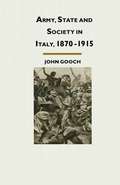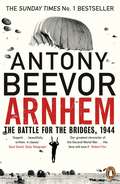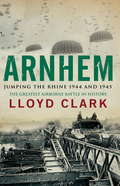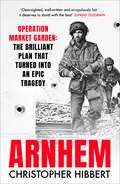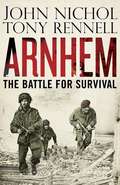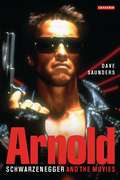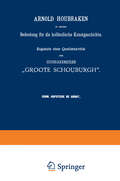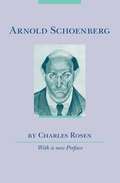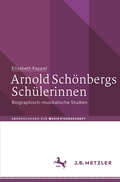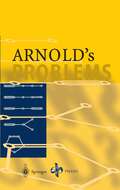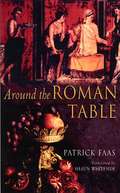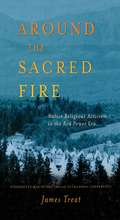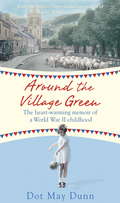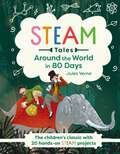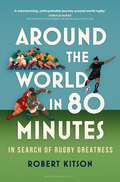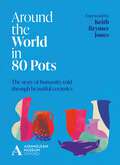- Table View
- List View
Arnheim, Gestalt and Media: An Ontological Theory (SpringerBriefs in Philosophy)
by Ian VerstegenThis monograph presents a synthesis and reconstruction of Rudolf Arnheim’s theory of media. Combining both Arnheim’s well-known writings on film and radio with his later work on the psychology of art, the author presents a coherent approach to the problem of the nature of a medium, space and time, and the differentia between different media. The latent ontological commitments of Arnheim’s theories is drawn out by affirming Arnheim’s membership in the Brentano school of Austrian philosophy, which allows his theories to be clarified and strengthened, particularly with the metaphysical writings of Roman Ingarden. The resulting theory is relational, portraying essential medial differences with neutral criteria and allowing for a rigorous definition of a medium. The way in which a medium is based on the inherent dispositions of medial materials creates a highly appealing theory that is determinate without being deterministic. The theory is thus highly timely as people in media studies seek to address the determinate nature of media after the post-medium condition. The book will appeal to researchers and graduate students in cultural and media studies as well as architecture and design.
Arnhem: The Battle for the Bridges, 1944: The Sunday Times No 1 Bestseller
by Antony BeevorThe Sunday Times #1 BestsellerThe great airborne battle for the bridges in 1944 by Britain's Number One bestselling historian and author of the classic Stalingrad'Our greatest chronicler of the Second World War . . . his fans will love it' - Robert Fox, Evening Standard'The eye for telling detail which we have come to expect from Antony Beevor. . . this time, though, he turns his brilliance as a military historian to a subject not just of defeat, but dunderhead stupidity' Daily Mail On 17 September 1944, General Kurt Student, the founder of Nazi Germany's parachute forces, heard the growing roar of aeroplane engines. He went out on to his balcony above the flat landscape of southern Holland to watch the air armada of Dakotas and gliders carrying the British 1st Airborne and the American 101st and 82nd Airborne divisions. He gazed up in envy at this massive demonstration of paratroop power. Operation Market Garden, the plan to end the war by capturing the bridges leading to the Lower Rhine and beyond, was a bold concept: the Americans thought it unusually bold for Field Marshal Montgomery. But could it ever have worked? The cost of failure was horrendous, above all for the Dutch, who risked everything to help. German reprisals were pitiless and cruel, and lasted until the end of the war. The British fascination with heroic failure has clouded the story of Arnhem in myths. Antony Beevor, using often overlooked sources from Dutch, British, American, Polish and German archives, has reconstructed the terrible reality of the fighting, which General Student himself called 'The Last German Victory'. Yet this book, written in Beevor's inimitable and gripping narrative style, is about much more than a single, dramatic battle. It looks into the very heart of war.'In Beevor's hands, Arnhem becomes a study of national character' - Ben Macintyre, The Times'Superb book, tirelessly researched and beautifully written' - Saul David, Daily Telegraph'Complete mastery of both the story and the sources' - Keith Lowe, Literary Review'Another masterwork from the most feted military historian of our time' - Jay Elwes, Prospect Magazine'The analysis he has produced of the disaster is forensic' - Giles Milton, Sunday Times'He is a master of his craft . . . we have here a definitive account' - Piers Paul Read, The Tablet
Arnhem: Nine Days of Battle
by Dr Chris BrownThe greatest airborne operation in history commenced on 17 September 1944. Nine days later nearly four out five of the British 1st Airborne Division and their Polish comrades would be killed, wounded or captured as Germany secured her last great battlefield victory of the war. The ferocious and gallant actions in Arnhem and Oosterbeek have fascinated historians and students ever since. Drawing extensively on eye-witness experience and unit diaries, and providing a detailed tactical and technical analysis of the arms, equipment and practices of the day, Arnhem: Nine Days of Battle provides a fascinating day-on-day account of one of the most iconic actions of the Second World War. Supported by battle maps, timelines, troop diagrams as well as touring guides – this is the perfect companion for the armchair historian or the intrepid battlefield traveller.
Arnhem: Jumping The Rhine 1944 And 1945
by Lloyd ClarkAn insightful and gripping account of the largest airborne operation in history. In September 1944, the river Rhine was a serious barrier to the advancing Allied armies in the West who were intent on charging Berlin and ending the war. Field Marshal Bernard Montgomery decided to utilise the First Allied Airborne Army consisting of British, American and Polish troops. Codenamed Operation Market Garden, 40,000 paratroopers were dropped behind enemy lines while ground forces linked to relieve them. But, due to bad weather and German resistance, the operation failed. In March 1945, asecond attempt was planned: Operation Varsity Plunder. This time the plan worked. Despite extremely heavy fighting, they cracked the German line.
Arnhem (GREAT BATTLES)
by Christopher HibbertThe vivid account of how a brilliant plan turned into an epic tragedy - made into the BAFTA award-winning film A BRIDGE TOO FAR'Alive with the detail that evokes the smoking background' DAILY TELEGRAPH'Finely recorded...truly the battle of Arnhem has been fortunate in its historian' SUNDAY TIMESThis book tells the true story of the Battle of Arnhem which was fought in September 1944. Nine thousand men of the First British Airborne Division were parachuted into the peaceful countryside that surrounded Arnhem. Their objective was to capture and hold the bridge over the Rhine ahead of the advancing British Second Army. Nine days later, after some of the fiercest street-fighting of the war, 2000 paratroopers managed to escape to safety.Made famous by the film A BRIDGE TOO FAR
Arnhem: The Classic Battle Told As Never Before
by Al Murray‘Utterly brilliant... this book really is the last word on the Battle of Arnhem’ James Holland’Superb... A military historian of originality and insight to compare with the best’ Saul David'This book is a revelation, not in facts delivered, but in the mood evoked. This is Arnhem unplugged By confining himself to men in and around Arnhem on that Tuesday, Murray achieves something special' The Times___________Al Murray has always been obsessed by this legendary battle, and in Arnhem: Black Tuesday he showcases all of his knowledge, interpretation and enthusiasm to bear to tell the story of one of history’s great heroic failures differently for the first time.The Battle of Arnhem is one of the best-known stories in British military history: a daring but doomed attempt to secure a vital bridgehead across the Rhine in order to end the war before Christmas 1944. It is always written about, with the benefit of unerring 20/20 hindsight, as being destined to fail, but the men who fought there, men of military legend, didn't know that that was to be their fate.By focusing on the events of one day as they happened through the eyes of the British participants and without bringing any knowledge of what would happen tomorrow to bear, Al Murray offers a very different perspective on a familiar narrative. Some things went right and a great many more went wrong, but recounting them in this way allows the reader to understand for the first time how certain decisions were taken in the moment and how opportunities were squandered.Tuesday 19 September 1944 was the terrible day which became known as Black Tuesday. From just after 12:00 hours while plans were being made to seize the initiative and optimism reigned, to the following midnight, when Arnhem was burning and the Allied fortunes looked very different, a mere twenty-four hours changed the course of the war.
Arnhem: The Battle for Survival
by John Nichol Tony RennellIn September 1944, a mighty shock force of battle hardened Allied troops dropped from the skies into enemy-occupied Holland in what was hoped would be the decisive final battle of World War II.Landing miles behind the German lines, their daring mission was to secure bridges across the Rhine so that ground forces could make a rapid dash into Nazi Germany. If all went well, the war could be over by Christmas.But what many trusted would be a simple operation turned into a brutal losing battle. Of 12,000 British airborne soldiers, 1,500 died and 6,000 were taken prisoner. The vital bridge at Arnhem they had come to capture stayed resolutely in German hands.But though this was a bitter military defeat for the Allies, beneath the humiliation was another story - of heroism and self-sacrifice, gallantry and survival, guts and determination unbroken in the face of impossible odds.In the two-thirds of a century that have passed since then, historians have endlessly analysed what went wrong and squabbled over who was to blame. Lost in the process was that other Arnhem story - the triumph of the human spirit, as seen through the dramatic first-hand accounts of those who were there, in the cauldron, fighting for their lives, fighting for their comrades, fighting for their honour, a battle they won hands down.
Arnhem: Fight Your Own Battle (EDGE: Battle Books #5)
by Gary SmailesTake up your weapons and prepare to fight your own battle in these all-action, interactive adventures, in which you take part in epic battles from throughout history.It is 1944 and Europe is still in the iron claw of Nazi German forces. In an attempt to end the war, British leaders have a plan to send elite troops deep behind German defences to capture key targets, including bridges. You are a Lieutenant in the 2nd Parachute Battalion. You must command your men forward through enemy territory and reach the bridge in the Dutch town of Arnhem. You must hold the bridge at any cost...
Arnhem Lift: A German Jew in the Glider Pilot Regiment
by Louis HagenOf the 10,000 men who landed at Arnhem, over nine days 1,400 were killed and more than 6,000 – about a third of them wounded – were captured. It wasa bloody disaster. The remarkable Louis Hagen, an ‘enemy alien’ who had escaped to England having been imprisoned and tortured in a Nazi concentration camp as a boy just a few years earlier, was one of the minority who made it back. What makes this book so unforgettable is not only the breathtaking drama of the story itself, it is the unmistakable talent of the writer. ‘Our huts had been locked and left just as they were when we left them on Monday morning. We took the keys, went in and sat down on our beds. The four of us looked round the hut. There were eighteen empty beds. It was very quiet now...The narrative was first published anonymously in 1945. 45 years later at a dinner party in Germany, Louis Hagen met Major Winrich Behr, Adjutant to Field Marshal Model at Arnhem. Louis added his side of the story to add even more insight to the original work.
Arnold: Schwarzenegger and the Movies
by Dave SaundersArnold: Schwarzenegger and the Movies' is the first comprehensive, in-depth book to examine one of modern cinema's most celebrated and divisive screen presences. Tracing Schwarzenegger's entire film career and life from teenage bodybuilder to Governor of California, Saunders blends close textual readings of the major films, including 'Pumping Iron', 'Conan the Barbarian', The 'Terminator' series, 'Twins' and 'True Lies', with salient historical context and biographical detail, demonstrating continually the importance of broader social and political factors in defining Arnold's unique significance. Representing far more than just a muscular spectacle, Saunders argues, Schwarzenegger found powerful ideological and spiritual relevance to his age by embarking on a quest to restore collective faith in his adopted nation - and, moreover, by exploiting his own, mythic importance to a post-war America struggling to come to terms with its own contemporary narrative.
Arnold Houbraken in seiner Bedeutung für die holländische Kunstgeschichte: Zugleich eine Quellenkritik der Houbrakenschen „Groote Schouburgh“
by Corn. Hofstede de GrootArnold Schoenberg (Princeton Legacy Library)
by Charles RosenIn this lucid, revealing book, award-winning pianist and scholar Charles Rosen sheds light on the elusive music of Arnold Schoenberg and his challenge to conventional musical forms. Rosen argues that Schoenberg's music, with its atonality and dissonance, possesses a rare balance of form and emotion, making it, according to Rosen, "the most expressive music ever written." Concise and accessible, this book will appeal to fans, non-fans, and scholars of Schoenberg, and to those who have yet to be introduced to the works of one of the greatest composers of the twentieth century. "Arnold Schoenberg is one of the most brilliant monographs ever to be published on any composer, let alone the most difficult master of the present age. . . . Indispensable to anyone seeking to understand the crucial musical ideas of the first three decades."—Robert Craft, New York Review of Books "What Mr. Rosen does far better than one could reasonably expect in so concise a book is not only elucidate Schoenberg's composing techniques and artistic philosophy but to place them in history."—Donal Henahan, New York Times Book Review "For the novice and the knowledgeable, Mr. Rosen's book is very important reading, either as an introduction to the master or as a stimulus to rethinking our opinions of him. Mr. Rosen's accomplishment is enviable."—Joel Sachs, Musical Quarterly
Arnold Schönbergs Schülerinnen: Biographisch-musikalische Studien (Abhandlungen zur Musikwissenschaft)
by Elisabeth KappelDiese Studie hat zum Ziel, das vorhandene Bild einer männlich dominierten Schönberg-Schule zu hinterfragen und Leben und Werk der Komponistinnen unter Arnold Schönbergs SchülerInnen zu erforschen. Durch intensive Recherchen kann die Liste bisher bekannter Schülerinnen und Schüler von etwa 300 auf mehr als 700 erweitert werden, darunter eine dreistellige Anzahl von Schülerinnen: Komponistinnen und Musikerinnen, von denen bis jetzt die wenigsten der Musikforschung bekannt sind. Die Studie beinhaltet neben einer kommentierten Auflistung der recherchierten Personen auf Basis bislang unerforschter Materialien Detailuntersuchungen zu 27 bedeutenden Schönberg-Schülerinnen, darunter – auf jeweils ca. 150 Seiten – Dika Newlin (Schönbergs jüngste Schülerin, 1923–2006) und Vilma Webenau (Schönbergs erste Schülerin, 1875–1953), und bietet damit eine wertvolle Plattform für weitergehende Forschungen.
Arnold's Problems
by V. I. Arnol'DVladimir Arnold is one of the most outstanding mathematicians of our time Many of these problems are at the front line of current research
Arnošt Frischer and the Jewish Politics of Early 20th-Century Europe
by Jan LánícekIn this analysis of the life of Arnošt Frischer, an influential Jewish nationalist activist, Jan Lánícek reflects upon how the Jewish community in Czechoslovakia dealt with the challenges that arose from their volatile relationship with the state authorities in the first half of the 20th century. The Jews in the Bohemian Lands experienced several political regimes in the period from 1918 to the late 1940s: the Habsburg Empire, the first democratic Czechoslovak republic, the post-Munich authoritarian Czecho-Slovak republic, the Nazi regime, renewed Czechoslovak democracy and the Communist regime. Frischer's involvement in local and central politics affords us invaluable insights into the relations and negotiations between the Jewish activists and these diverse political authorities in the Bohemian Lands. Vital coverage is also given to the relatively under-researched subject of the Jewish responses to the Nazi persecution and the attempts of the exiled Jewish leadership to alleviate the plight of the Jews in occupied Europe.The case study of Frischer and Czechoslovakia provides an important paradigm for understanding modern Jewish politics in Europe in the first half of the 20th century, making this a book of great significance to all students and scholars interested in Jewish history and Modern European history.
Arnošt Frischer and the Jewish Politics of Early 20th-Century Europe
by Jan LánícekIn this analysis of the life of Arnošt Frischer, an influential Jewish nationalist activist, Jan Lánícek reflects upon how the Jewish community in Czechoslovakia dealt with the challenges that arose from their volatile relationship with the state authorities in the first half of the 20th century. The Jews in the Bohemian Lands experienced several political regimes in the period from 1918 to the late 1940s: the Habsburg Empire, the first democratic Czechoslovak republic, the post-Munich authoritarian Czecho-Slovak republic, the Nazi regime, renewed Czechoslovak democracy and the Communist regime. Frischer's involvement in local and central politics affords us invaluable insights into the relations and negotiations between the Jewish activists and these diverse political authorities in the Bohemian Lands. Vital coverage is also given to the relatively under-researched subject of the Jewish responses to the Nazi persecution and the attempts of the exiled Jewish leadership to alleviate the plight of the Jews in occupied Europe.The case study of Frischer and Czechoslovakia provides an important paradigm for understanding modern Jewish politics in Europe in the first half of the 20th century, making this a book of great significance to all students and scholars interested in Jewish history and Modern European history.
Around The Roman Table (PDF): Food And Feasting In Ancient Rome
by Patrick Faas Shaun WhitesideCraving dolphin meatballs? Can't find a reliable restaurant for boiled parrot? Have a hankering for jellyfish omelettes, sows' wombs in brine, sheep's brain pate, or stuffed mice? Look no further than Around the Roman Table, a unique hybrid cookbook and history lesson. A portrait of Roman society from the vantage point of the dining table, kitchen, and market stalls, Around the Roman Table offers both an account of Roman eating customs and 150 recipes reconstructed for the modern cook. Faas guides readers through the culinary conquests of Roman invasions-as conquerors pillaged foodstuffs from faraway lands-to the decadence of Imperial Rome and its associated table manners, dining arrangements, spices, seasonings, and cooking techniques. With recipes for such appetizing dishes as chicken galantine with lambs' brains and fish relish, Around the Roman Table is ideal for food aficionados who wish to understand how the desire for power and conquest was manifested in Roman appetites.
Around the Roman Table: Food And Feasting In Ancient Rome
by Patrick FaasA quirky and unusual historical cookery book, already a bestseller in Europe. Packed with fascinating anecdotes, and richly illustrated with witty quotes from classical authors, Around the Roman Table is a mouth-watering ride through the food of the ancient world and, as a recipe book, a step back in time. But it is not just the absence of gas-fired hobs and microwaves which make this such a unique experience. America had yet to be discovered, hence ingredients such as potatoes, tomatoes, red peppers and peanuts could not grace the Roman table. This lack of the staples of the European diet, was more than made up for by Roman appetite for foodstuffs we would scarcely feed our dogs. Fish eyes, pigs' ears, wombs, intestines and brains were all served, usually dressed in fiery pepper based sauces. Not all the recipes resort to such unusual fare and over 150 are reproduced here, especially adapted to allow modern cooks to revive ancient dishes in their own kitchens.
Around the Sacred Fire: Native Religious Activism in the Red Power Era
by J. TreatAround the Sacred Fire is a compelling cultural history of intertribal activism centered on the Indian Ecumenical Conference, an influential movement among native people in Canada and the U.S. during the Red Power era. Founded in 1969, the Conference began as an attempt at organizing grassroots spiritual leaders who were concerned about the conflict between tribal and Christian traditions throughout Indian country. By the mid-seventies thousands of people were gathering each summer in the foothills of the Rockies, where they participated in weeklong encampments promoting spiritual revitalization and religious self-determination. Most historical overviews of native affairs in the sixties and seventies emphasize the prominence of the American Indian Movement and the impact of highly publicized confrontations such as the Northwest Coast fish-ins, the Alcatraz occupation, and events at Wounded Knee. The Indian Ecumenical Conference played a central role in stimulating cultural revival among native people, partly because Conference leaders strategized for social change in ways that differed from the militant groups. Drawing on archival records, published accounts, oral histories, and field research, James Treat has written the first comprehensive study of this important but overlooked effort at postcolonial interreligious dialogue.
Around the Village Green: The Heart-Warming Memoir of a World War II Childhood (Christmas Fiction Ser.)
by Dot May DunnThe heart-warming tale of a wartime childhood.It's 1939 and little Dot May Dun is playing with her brothers in the quiet lanes of their Derbyshire village. The grown-ups' talk of war means very little to Dot but things are starting to change in the village, for good.When a prisoner of war camp is built close to Dot's village, and a Yankee base is stationed nearby, Dot makes friends with the most unlikely of soldiers. But her friendships are threatened when telegrams start to arrive in the village and the real impact of war bears heavily on this close-knit mining community.From little lives spring great tales. Dot's childhood memoir shares the universals of innocence, love, loss and friendships. THE VILLAGE will move and entertain in equal measures.
Around the World in 80 Days: The children's classic with 20 hands-on STEAM projects (Around the World in 80 #1)
by Jules Verne Katie DickerFire up young readers' imagination and creativity with this classic story featuring added STEAM activities.This beloved children's adventure is retold with vivid and engaging new illustrations – and at the end of every chapter, there are exciting new science, technology, engineering, art and mathematics activities, themed around the events in the book. The activities range from simple puzzles to fun, dynamic experiments, so there's something for every enquiring mind. It's the ideal combination of enchanting story and stimulating science fun.
Around the World in 80 Minutes: In Search of Rugby Greatness
by Robert Kitson'A mesmerising, unforgettable journey around world rugby. ' – Donald McRae – Twice Winner of the William Hill Sports Book of the Year'Magnificent… a hugely intelligent and entertaining interweaving series of tales that gets into the “how” of rugby.' - Stuart Barnes, Sunday Times and Times columnist, former Bath and England fly half---Contrasting characters, colliding cultures, the same oval-shaped ball. A journey to find the game's most remarkable people, teams and places, and unearth the true meaning of rugby greatness.What makes rugby special? Which individuals and teams have defined the modern game? Ahead of the 2023 Rugby World Cup in France, Around the World in 80 Minutes charts the 'golden era' of global rugby union between 1973 and 2023 and goes in search of the sport's most influential trailblazers.Robert Kitson, the Guardian's long-time rugby union correspondent, assesses the game's current health, tracks down the battered gladiators of yesteryear and asks some pertinent questions. Does rugby retain its old rugged charm? What does its future look like? And what, ultimately, constitutes rugby 'greatness'?Observant, amusing and thought-provoking, the journey takes in some of the game's more prominent names – including David Campese, Brian O'Driscoll, Maggie Alphonsi, Sean Fitzpatrick, Eddie Jones and Sir Clive Woodward – to reflect on rugby's intangible shared joy.Millions of fans continue to find rugby maddeningly irresistible and endlessly compelling. This book is for them, and for anyone else wondering where the appeal lies.
Around the World in 80 Minutes: In Search of Rugby Greatness
by Robert Kitson'A mesmerising, unforgettable journey around world rugby. ' – Donald McRae – Twice Winner of the William Hill Sports Book of the Year'Magnificent… a hugely intelligent and entertaining interweaving series of tales that gets into the “how” of rugby.' - Stuart Barnes, Sunday Times and Times columnist, former Bath and England fly half---Contrasting characters, colliding cultures, the same oval-shaped ball. A journey to find the game's most remarkable people, teams and places, and unearth the true meaning of rugby greatness.What makes rugby special? Which individuals and teams have defined the modern game? Ahead of the 2023 Rugby World Cup in France, Around the World in 80 Minutes charts the 'golden era' of global rugby union between 1973 and 2023 and goes in search of the sport's most influential trailblazers.Robert Kitson, the Guardian's long-time rugby union correspondent, assesses the game's current health, tracks down the battered gladiators of yesteryear and asks some pertinent questions. Does rugby retain its old rugged charm? What does its future look like? And what, ultimately, constitutes rugby 'greatness'?Observant, amusing and thought-provoking, the journey takes in some of the game's more prominent names – including David Campese, Brian O'Driscoll, Maggie Alphonsi, Sean Fitzpatrick, Eddie Jones and Sir Clive Woodward – to reflect on rugby's intangible shared joy.Millions of fans continue to find rugby maddeningly irresistible and endlessly compelling. This book is for them, and for anyone else wondering where the appeal lies.
Around the World in 80 Pots: The story of humanity told through beautiful ceramics
by Ashmolean MuseumPottery tells us about religion, daily life, humour, trade, sex, folklore and creativity. Bearing the imprint of their maker more than any other crafted object, ceramics give us a unique physical link to the past, often the only evidence of long-forgotten civilizations that have otherwise crumbled to dust.From ancient Egyptian canopic death jars to ethereally beautiful porcelain, and from lewd Renaissance novelties to sleek contemporary vessels, Around the World in 80 Pots is an eclectic journey across time and cultures. Expertly selected from the unrivalled collection of the University of Oxford's Ashmolean Museum, this compendium shows that humankind's oldest craft is the perfect prism through which to view human history.
